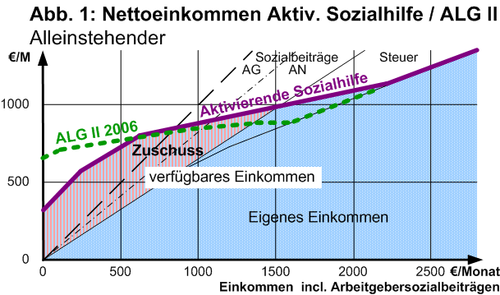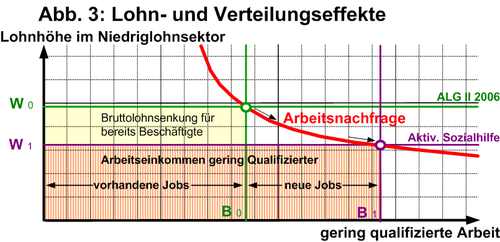Activating social assistance
In the 2000s, the model of activating social assistance provided for financial support for employees in the newly created and promoted low-wage area instead of granting wage replacement benefits ( unemployment benefit ) . The concept contains three main elements:
- a reduction in social assistance for employable but not employed social assistance recipients,
- a bonus for workers in the low-wage sector and
- the obligation of the state. offer public employment to all unemployed social welfare recipients.
The model comes from the President of the Ifo Institute, Hans-Werner Sinn . Hans-Werner Sinn (together with Christian Holzner , Wolfgang Meister, Wolfgang Ochel and Martin Werding ) first presented the concept of “activating social assistance” in May 2002. The Ifo Institute presented a new version of the concept shortly after Angela Merkel took office as Federal Chancellor in January 2006 .
The basic conceptual approach of the model
The number of unemployed rose steadily in Germany until the mid-2000s. Hans-Werner Sinn found that the unemployment rate among academics had remained more or less constant since the 1970s, while the unemployment rate among people with vocational training had doubled from 4 percent in 1975 to 8 percent in 2004. The widespread explanation, according to which the last-mentioned development can (also) be traced back to increasing automation and technical progress, considers Sinn to be plausible. However, the unemployment rate for people without vocational training nearly quadrupled (from 6 percent in 1975 to 22 percent in 2004) in other OECD countries.
From this, Sinn drew the conclusion in the 2000s that what he saw as the overly generous system of wage replacement payments in Germany had apparently prevented the formation of a low-wage sector for legal work. He considered its existence to be the most important prerequisite for a higher employment rate among the low-skilled. Sinn saw the West faced with enormous problems due to increasingly fierce competition for low wages. In his opinion it was necessary to eliminate the competitive situation between the welfare state and private employers through a wage supplement system.
Gerhard Schröder and Tony Blair had already published the so-called Schröder-Blair paper on the occasion of the 1999 European elections in June 1999 , in which above all a conversion of the welfare state from a caring to an activating welfare state was demanded. The Ifo studies of 2002 and 2006 are to be seen as contributions to the corresponding discourse. The conceptual approach of 2002 is outdated in that since the merging of unemployment benefits and social assistance in the course of the Hartz reforms, no employable welfare recipient has to "queue in a kind of queue behind recipients of unemployment benefit and unemployment assistance".
Criticism of the earlier existing wage replacement system
In the social welfare system that existed before Chancellor Gerhard Schröder took office , Sinn particularly criticized its employment-inhibiting effect. Wage conditions that create a net income only slightly above social assistance level even with top-up ALG II, de facto did not come about due to the existing wage replacement system. For Sinn, this is the main reason for the significantly high unemployment rate of the low-skilled in the international comparison in the mid-2000s.
The activating social welfare model
Instead of the essentially existing wage replacement system, the activating social assistance provides for a wage supplement system. If, after the introduction of the system, a previously unemployed person takes up employment in the low-wage sector, he will still receive state support. This support decreases with increasing income, but in any case it ensures that someone who works is much better off than someone who does not work if he is in need (i.e. not in the sense of the principle of subsidiarity has the opportunity and the obligation to other ways to legally increase income). In this respect, the supplementary benefits function like a negative income tax . If the beneficiary does not succeed in achieving a higher income, the support is granted to the person who remains in employment as a permanent benefit for an unlimited period. At the same time, state social benefits for employable people who are assessed as not willing to work will be significantly reduced, by 30 percent compared to the previous system.
So that this reduction really only affects those “unwilling to work” and the constitutionally required solidarity is still guaranteed, the municipalities undertake to offer everyone who shows a need for employment in municipal management, which is remunerated in the amount of the previous ALG II, so that the so Employees do not earn more than in the low-wage sector. The municipal employees can be hired out to the private sector with the help of private temporary employment agencies.

For the 2006 model, Figure 1 shows the effect on the net income per month in relation to gross wages including employers' social contributions, i.e. the actual labor costs. You can see how your own net income (blue) remaining after deduction of social contributions and taxes is increased to the disposable income for the combined wage (blue-red). For comparison, the net income for ALG II (green dashed line) is shown.

Figure 2 shows the net income gain an employee receives depending on the gross hourly wage for full-time jobs, i.e. the net gain from taking up work. The incentive to work is tripled in the range up to 11 euros.

Figure 3 shows how the potential wage reduction increases the demand for labor and creates new jobs. The gross wages of the existing low-wage jobs decrease. However, net income would tend to rise due to the combined wage effect of activating social assistance.
In the long term, the Ifo Institute forecast employment opportunities for 3.2 million people through activating social assistance in the 2000s.
In addition, according to the Institute's calculations, the implementation of the model would have meant considerable savings compared to the system to be replaced, which could have been 7.7 billion euros in the medium term and 21 billion euros in the long term.
Modifications
Sinn also provided for a modification of the system in which entry would have taken place at the subsistence level . This would have come close to the concepts of an unconditional basic income . However, these modifications could not have offered the same work incentive by far. Sinn believed that without his plans, overcoming the high unemployment rates of the 2000s would not be possible.
criticism
Regina Konle-Seidl found in her research on the effect of state measures for activating the unemployed in an international comparison in 2008 that “checking the actual availability, potential employability and actual ability to work is an important prerequisite for a successful activation policy.” Even if one is low Would allow market wages, it would remain z. For example, it is difficult to treat childcare problems for single parents , impairments such as illiteracy and health impairments below the threshold of incapacity in such a way that everyone who is in principle able to work can get a job.
Thomas Straubhaar points out that the digital revolution will make a large number of activities superfluous and the socially necessary working hours will decrease drastically. Under these conditions it is counterproductive to force people to increase the number of jobs and work at very low wages. In response to the objection that there is hardly anyone who voluntarily cleans toilets or wants to remove bowels from pigs, Straubhaar says: “That's good. These people could now say no [ie after the introduction of an unconditional basic income ], they no longer have the material pressure to have to work. Today our system forces through material hardship that people take jobs that are actually inhumane, that nobody likes to do and that are still very poorly paid. We also accept that these people live shorter lives. With an unconditional basic income, however, they would have a choice. The consequences: Employers have to consider whether machines or robots can do the job and change their processes more quickly. Digitization offers a historic opportunity. If we don't use them, it's a sin. If that is not possible, the wages for these jobs have to rise so that people are ready for a few hours to do things that today they have to do for a lifetime against their will. "
Individual evidence
- ↑ Wolfgang Strengmann-Kuhn : “Activating Social Assistance - A Way to More Employment and Growth?” - An answer to the proposal of the Ifo Institute . Frankfurt / Main 2003
- ↑ Hans-Werner Sinn u. a .: Activating social assistance - a way to more jobs and growth . May 14, 2002
- ^ Institute for Economic Research at the University of Munich: Activating Social Aid 2006: The Combined Wage Model of the Ifo Institute. Presented at a federal press conference ( memento of the original from March 5, 2017 in the Internet Archive ) Info: The archive link was inserted automatically and has not yet been checked. Please check the original and archive link according to the instructions and then remove this notice. . January 26, 2006
- ↑ Hans-Werner Sinn: Essay: Why the European welfare state does not survive globalization. Welt N24, March 1, 2006, accessed March 17, 2017 .
- ^ The way forward for Europe's social democrats. A suggestion by Gerhard Schröder and Tony Blair London, June 8, 1999
- ^ Frank Oschmiansky: Dossier Labor Market Policy: Activating State and Activating Labor Market Policy . Federal Agency for Political Education . June 1, 2010
- ^ Regina Konle-Seidl: Aid reforms and activation strategies in an international comparison . IAB Research Report 7/2008. P. 101
- ↑ Thomas Straubhaar: The basic income replaces the welfare state . In: Capital . February 16, 2017 ( online )